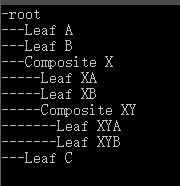我们来讲一下组合模式:
怎么是组合模式呢?组合模式,将对象组合成树形结构以表示‘部分-整体’的层次结构,组合模式是的用户对单个对象和组合对象的用用具有一致性。
与一个很简单的例子,公司的组织架构,大都是树枝结构的。下面,我们来看一下如何用组合模式写树枝结构。
1 //接口用于访问和管理Component的子部件 2 abstract class Component 3 { 4 5 protected string name; 6 7 public Component(string name) 8 { 9 this.name = name; 10 } 11 12 //通常都用Add 和Remove 方法来提供增加或移除树叶或树枝的功能 13 public abstract void Add(Component c); 14 public abstract void Remove(Component c); 15 public abstract void Display(int depth); 16 }
1 //Leaf在组合中表示叶节点对象,叶节点没有子节点 2 class Leaf:Component 3 { 4 public Leaf(string name) : base(name) 5 { 6 } 7 //由于叶子没有再增加分支和树叶,所以Add 和Remove 方法实现它没有意义,但这样做可以消除叶节点和枝节点 8 //在抽象层次的区别,它们具备完全一直的接口 9 public override void Add(Component c) 10 { 11 Console.WriteLine("Can't add to a leaf"); 12 } 13 14 public override void Remove(Component c) 15 { 16 Console.WriteLine("Can't remove from a leaf"); 17 } 18 19 public override void Display(int depth) 20 { 21 Console.WriteLine(new String('-',depth)+name); 22 } 23 }
1 //Composite定义有枝节点行为,用来储存子部件,在Component接口中实现与子部件有关的操作 2 //比如增加Add 和 删除 Remove 3 class Composite:Component 4 { 5 //一个子对象集合用来存储其下属的枝节点和叶节点 6 private List<Component> children = new List<Component>(); 7 public Composite(string name) : base(name) 8 { 9 } 10 11 public override void Add(Component c) 12 { 13 children.Add(c); 14 } 15 16 public override void Remove(Component c) 17 { 18 children.Remove(c); 19 } 20 21 public override void Display(int depth) 22 { 23 //显示其枝节点名称,并对其下级进行遍历 24 Console.WriteLine(new String('-',depth)+name); 25 foreach (Component component in children) 26 { 27 component.Display(depth + 2); 28 } 29 } 30 }
客户端
public static void Main() { //生成树根root,根上长出两叶LeafA 和 LeafB Composite root = new Composite("root"); root.Add(new Leaf("Leaf A")); root.Add(new Leaf("Leaf B")); //根上长出分支CompositX //分支上也有两叶LeafXA和LeafXB Composite comp = new Composite("Composite X"); comp.Add(new Leaf("Leaf XA")); comp.Add(new Leaf("Leaf XB")); root.Add(comp); //在Composite X 上在长出分支 Composite XY //分支上也有两叶LeafXYA 和 LeafXYB Composite comp2 = new Composite("Composite XY"); comp2.Add(new Leaf("Leaf XYA")); comp2.Add(new Leaf("Leaf XYB")); comp.Add(comp2); root.Add(new Leaf("Leaf C")); Leaf leaf = new Leaf("Leaf D"); root.Add(leaf); root.Remove(leaf); root.Display(1); Console.ReadKey(); }
结果:

好,是不是很简单啊……
那么,什么时候用组合模式呢?当你发现需求中是体现部分与整体层次的结构时,以及你希望用户可以忽略组合对象与单个对象的不同,统一地使用组合结构中的所有对象时,就应该考虑用组合模式了。
组合模式就先讲到这里,下一篇博文,我们讲 迭代器模式
本系列将持续更新,喜欢的小伙伴可以点一下关注和推荐,谢谢大家的支持